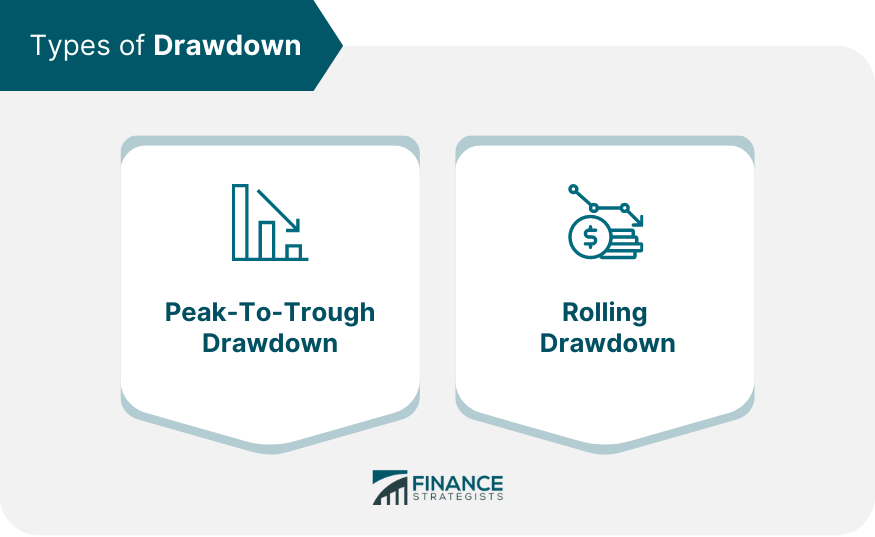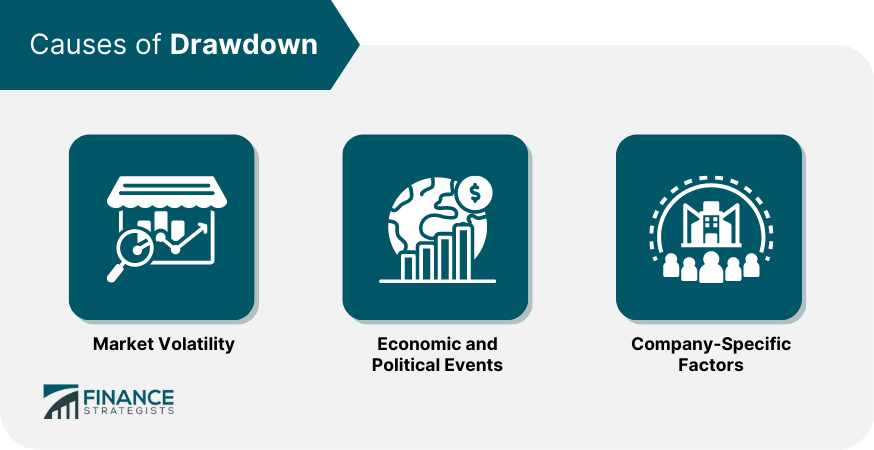Drawdown refers to the decline in the value of an investment or portfolio from its peak to its lowest point. It is a measure of the maximum loss incurred during a specific period and is an important concept in finance and investment. Drawdown is an essential concept in finance and investment as it provides a measure of risk and potential loss. It is particularly important for investors who seek to maximize returns while managing risk. Drawdown can help investors identify potential downside risks and make informed decisions about asset allocation, risk management, and investment strategies. Drawdown is also a critical measure in evaluating the performance of investment managers, as it indicates how much an investment or portfolio has lost during a specific period. By understanding drawdown, investors can assess the potential risks associated with a particular investment or portfolio and make more informed decisions. Peak-to-trough drawdown refers to the decline in the value of an investment or portfolio from its highest point to its lowest point. It is a measure of the maximum loss incurred during a specific period, typically expressed as a percentage of the peak value. Peak-to-trough drawdown can be useful for investors in assessing the maximum loss incurred during a particular market cycle or investment period. By understanding peak-to-trough drawdown, investors can identify the potential risks associated with an investment and make informed decisions about asset allocation and risk management strategies. Rolling drawdown refers to the decline in the value of an investment or portfolio from its highest point to its subsequent lowest point over a particular rolling period. It is a measure of the maximum loss incurred during a specific period, typically expressed as a percentage of the peak value. Rolling drawdown can be useful for investors in assessing the consistency of an investment's performance over time. By understanding rolling drawdown, investors can identify the potential risks associated with an investment and make informed decisions about asset allocation and risk management strategies. The drawdown formula is the difference between the peak value and the lowest point of an investment or portfolio, divided by the peak value. The formula is expressed as a percentage of the peak value. For example, if an investment's peak value was $100,000, and its lowest value was $80,000, the drawdown would be calculated as follows: Drawdown = ($100,000 - $80,000) / $100,000 * 100% = 20% This indicates that the investment incurred a 20% drawdown from its peak value. Drawdown can be interpreted as a measure of the maximum loss incurred during a specific period. The higher the drawdown, the greater the potential risk associated with the investment or portfolio. Investors should use drawdown as a measure of risk and make informed decisions about asset allocation and risk management strategies based on the drawdown level. It is also important to note that drawdown is a temporary measure of risk, and investments can recover from drawdowns over time. Therefore, investors should consider drawdown in the context of their investment horizon and long-term financial goals. Market volatility can cause drawdowns in investments and portfolios. As market conditions change, the value of investments can fluctuate, leading to potential losses. Market volatility can be caused by a variety of factors, including economic indicators, political events, and company-specific news. Economic and political events can also cause drawdowns in investments and portfolios. For example, an unexpected change in interest rates or inflation can cause fluctuations in the value of investments. Similarly, political events such as elections or geopolitical tensions can cause uncertainty in the markets and lead to potential losses. Company-specific factors, such as poor financial performance or management decisions, can also cause drawdowns in individual stocks or portfolios. For example, a company's stock may decline due to a decline in earnings or negative news about the company's management or operations. Drawdown is an important tool for managing risk in investments and portfolios. By understanding the potential drawdown associated with an investment, investors can make informed decisions about asset allocation and risk management strategies. Drawdown limits and guidelines can be used to manage risk and minimize potential losses. For example, investors may set a maximum drawdown limit for their portfolio, beyond which they will reduce their exposure to the investment or asset. Hedging strategies can also be used to manage drawdown risk. For example, options contracts can be used to protect against potential losses in investments, while diversification can be used to reduce exposure to a particular asset or sector. Drawdown can play a role in portfolio construction and asset allocation. By considering the potential drawdown associated with an investment or asset, investors can create a more diversified and risk-managed portfolio. Drawdown can also have an impact on portfolio performance, as it can affect the overall return of the portfolio. Investors should consider the potential drawdown associated with an investment or asset when evaluating its potential returns. Drawdown can also be used to inform asset allocation decisions. By understanding the potential drawdown associated with different asset classes, investors can make informed decisions about the allocation of their investment portfolio. Behavioral biases can play a role in how investors perceive and respond to drawdowns. For example, investors may exhibit a loss aversion bias, where they are more sensitive to losses than gains. Drawdown can also elicit emotional responses from investors, such as fear or panic. These emotional responses can lead to irrational investment decisions and potentially exacerbate drawdowns. Managing behavioral biases during drawdowns can be challenging but important for investors. By remaining disciplined and sticking to a long-term investment strategy, investors can avoid making impulsive decisions based on emotional responses. Drawdown is an essential concept in finance and investment, providing a measure of potential risk and loss. It is important for investors to understand drawdown and its implications for investment decision-making and risk management. Drawdown can inform investment decision-making, asset allocation, and risk management strategies. By understanding drawdown, investors can make informed decisions about their investment portfolios and manage potential risks effectively.Definition of Drawdown
Types of Drawdown
Peak-to-Trough Drawdown
Rolling Drawdown

Calculation and Interpretation of Drawdown
Drawdown Formula
Drawdown Example and Calculation
Interpretation of Drawdown
Causes of Drawdown
Market Volatility
Economic and Political Events
Company-Specific Factors

Drawdown and Risk Management
Role of Drawdown in Risk Management
Drawdown Limits and Guidelines
Hedging Strategies for Drawdown Risk
Drawdown and Portfolio Management
Drawdown in Portfolio Construction
Impact of Drawdown on Portfolio Performance
Drawdown and Asset Allocation
Drawdown and Behavioral Finance
Behavioral Biases and Drawdown
Emotional Response to Drawdown
Managing Behavioral Biases During Drawdowns
Bottom Line
Drawdown FAQs
A drawdown is a decline in the value of an investment from its peak to its low.
There are two types of drawdowns: peak-to-trough and cumulative.
To calculate drawdown, subtract the lowest point of an investment from its peak value, and divide the result by the peak value.
Drawdowns can be caused by various factors, including market volatility, economic downturns, and company-specific events.
To manage drawdown, investors can use strategies such as diversification, risk management techniques, and following a long-term investment plan.
True Tamplin is a published author, public speaker, CEO of UpDigital, and founder of Finance Strategists.
True is a Certified Educator in Personal Finance (CEPF®), author of The Handy Financial Ratios Guide, a member of the Society for Advancing Business Editing and Writing, contributes to his financial education site, Finance Strategists, and has spoken to various financial communities such as the CFA Institute, as well as university students like his Alma mater, Biola University, where he received a bachelor of science in business and data analytics.
To learn more about True, visit his personal website or view his author profiles on Amazon, Nasdaq and Forbes.











